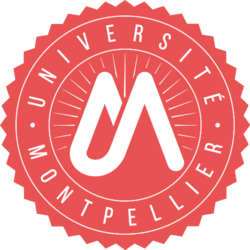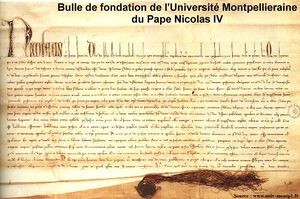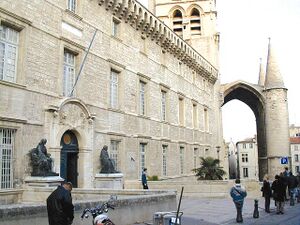University of Montpellier
(University) | |
|---|---|
 | |
| Formation | 1289 |
| Headquarters | Montpellier, |
| Along with Paris, Toulouse and Aix-en-Provence, Montpellier is one of the largest student cities in France | |
The University of Montpellier ({Université de Montpellier) is a French public research university in Montpellier in south-east of France. Established in 1220, the University of Montpellier is one of the oldest universities in the world.
The university was split into three universities (the University of Montpellier 1, the University of Montpellier 2 and the Paul Valéry University Montpellier 3) for 45 years from 1970 until 2015 when it was subsequently reunified by the merger of the two former,[1] with the latter, now named Paul Valéry University Montpellier, remaining a separate entity.
History

The university is considerably older than its formal founding date, associated with a papal bill issued by Pope Nicholas IV in 1289, combining all the centuries-old schools into a university.,[2] but the first statutes were given by Conrad of Urach in 1220.
It is not known exactly when the schools of liberal arts were founded that developed into the Montpellier faculty of arts; it may be that they were a direct continuation of the Gallo-Roman schools that gathered around masters of rhetoric. The school of law was founded by Placentinus, from the school of law at Bologna, who came to Montpellier in 1160, taught there during two different periods, and died there in 1192. The faculty of law has had a long career. Professors from Montpellier were prominent in the drafting of the Napoleonic Code, the civil code by which France is still guided and a foundation for modern law codes wherever Napoleonic influence extended. The faculty of law was reorganized in 1998.
The prestigious school of medicine was founded perhaps by people trained in the Spanish medical schools; it is certain that, as early as 1137, there were excellent physicians at Montpellier University. It is the world's oldest medical school still in operation. The school of medicine owed its success to a policy of the Guilhem lords of Montpellier, by which any licensed physician might lecture there: with no fixed limit to the number of teachers, lectures multiplied, thus providing a great choice of teachers coming from all around the Mediterranean region (Guilhem VIII act of January 1181).[3] The statutes given in 1220 by Cardinal Conrad von Urach, legate of Pope Honorius III, which were confirmed and extended in 1240, placed this school under the direction of the Bishop of Maguelonne, but the school enjoyed a great deal of de facto autonomy.
The school was famous for arguing in the fourteenth century that the Black Death was caused by a miasma entering the opening of the body's pores, citing theories developed by Galen. Doctors educated at Montpellier advocated against bathing because they claimed bathing opened the body's pores, making one more susceptible to the bubonic plague.[4]
In 1529, after some years as an apothecary, Nostradamus entered the University of Montpellier to study for a doctorate in medicine. He was expelled shortly afterwards when it was discovered that he had been an apothecary, a "manual trade" expressly banned by the university statutes.[8] The expulsion document (BIU Montpellier, Register S 2 folio 87) still exists in the faculty library. Rabelais took his medical degree at Montpellier, and his portrait hangs among the gallery of professors.
The Jardin des plantes de Montpellier, founded in 1593, is the oldest botanical garden in France. It was in this school that the biological theory of vitalism, elaborated by Barthez (1734–1806), had its origin. The French Revolution did not interrupt the existence of the faculty of medicine. The Benedictine monastery that had been converted into the bishop's palace, was given to house the medical school in 1795. A gallery devoted to the portraits of professors since 1239 contains one of Rabelais.
The school of theology had its origins in lectures in the convents: St. Anthony of Padua, Raymundus Lullus, and the Dominican Bernard of Trilia all lectured. Two letters of King John II prove that a faculty of theology existed at Montpellier independently of the convents, in January 1350. By a Bull of 17 December 1421, Pope Martin V granted canonical institution to this faculty and united it closely with the faculty of law.
In the 16th century the local triumph of Calvinism interrupted the somewhat somnolent Catholic school of theology, which was reinstated in 1622; but the rivalries of Dominicans and Jesuits interfered seriously with the prosperity of the faculty, which disappeared at the Revolution. In better days, among Montpellier's illustrious pupils of law were Petrarch, who spent four years at Montpellier, and among its lecturers were William of Nogaret, chancellor to Philip IV, Guillaume de Grimoard, afterwards Pope Urban V, and Pedro de Luna, afterwards antipope Benedict XIII.
Like all other provincial universities of France, that of Montpellier was suppressed at the outbreak of the French Revolution in 1793. The faculties of science and of letters were re-established in 1810; that of law in 1880. The university of Montpellier was officially re-organised in 1969, on the aftermath of May 1968 and the students' revolt all over the country. It was split into its successor institutions the University of Montpellier 1 (comprising the former faculties of medicine, law, and economy), University of Montpellier 2 (science and technology) and University of Montpellier 3 (social sciences, humanities and liberal arts).
On 1 January 2015, the University of Montpellier 1 and the University of Montpellier 2 merged to form the newly recreated University of Montpellier. Meanwhile, the Paul Valéry University Montpellier 3, now only Paul Valéry, remains a separate institution.
Notable alumni
Over the course of its history, a sizeable number of University of Montpellier alumni have become notable in their fields, both academic, and in the wider world.[5]
- Francesco Petrarca, Italian scholar and poet in Renaissance Italy, widely considered to be the founder of Humanism
- Amalricus Augerii, 14th-century church-historian
- François Rabelais, humanist writer
- Alexander Grothendieck, 20th-century mathematician, Fields Medal winner
- Enver Hoxha, communist dictator of Albania from 1944 until his death in 1985
- Taha Hussein, was one of the most influential 20th-century Egyptian writers
- Albert Zafy, President of Madagascar 1993–96
- Khieu Samphan, Head of State of Cambodia under Pol Pot's Khmer Rouge regime
- Nostradamus, a French apothecary and reputed seer, who is best known for his book Les Propheties
- Raja Rao, one of three primary Indian Writers in English, awarded the Neustadt Prize in 1988
- Adamantios Korais, a Greek scholar and a major figure in the Greek Enlightenment
- Sahle-Work Zewde, is an Ethiopian politician and diplomat who is the current President of Ethiopia, the first woman to hold the office
- Mohed Altrad, a Syrian-born French billionaire businessman, rugby chairman and writer
- Andreas Vesalius , Wrote the "Corporis Fabrica Libri Septem", the first Medical Anatomy book based on human anatomy rather than animal anatomy.
- Edward Adam, a 19th century chemist who invented methods to improve the distillation of liquor.
- Li Jieren, noted 20th-century Chinese author and translator, studied literature at Montpellier, 1922-1924.
- Zhou Taixuan, Chinese biologist and poet, earned a Masters degree in education at Montpellier in 1924.
An Alumnus on Wikispooks
| Person | Summary | Description |
|---|---|---|
| Irene Martínez Fernández | Researcher | Joined the Institute for Statecraft as an associate researcher in July 2019 |
References
- ↑ http://www.lamarseillaise.fr/herault-du-jour/education/34545-l-universite-de-montpellier-a-l-epreuve-de-la-fusion
- ↑ http://www.umontpellier.fr/universite/histoire-de-luniversite/
- ↑ Gad Freudenthal, Samuel S. Kottek, Paul Fenton (2002) https://books.google.com/books?id=SVm_Ycxj6p0C&pg=PA103 Mélanges d'histoire de la médecine hébraïque, BRILL, ISBN 90-04-12522-1
- ↑ https://books.google.com/books?id=oK4HTBcdSJsC&pg=PA112
- ↑ For a summary description of all of the set of scholars and literati who intervened in teaching at the University of Montpellier since its inception to the eve of the Industrial Revolution (1800), see David de la Croix, (2021), Scholars and Literati at theUniversity of Montpellier (1706-1793), Repertorium Eruditorum Totius Europae/RETE, 1: 33-39.
